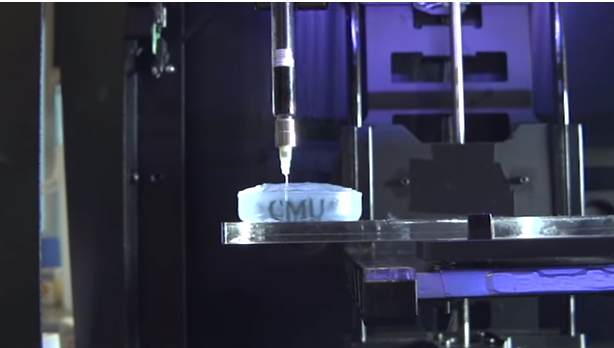Policymakers Want to Know More About 3D Printing & Economic Impact—Carnegie Mellon Faculty Participate in Briefing to Congress
 The US government, while always under fire from one political element or another, certainly cannot be criticized for being too slow or lacking enthusiasm in embracing 3D printing on any level. From White House holiday decorations that were 3D printed a couple of years ago to a widespread STEM curriculum agenda which has even had worldwide impact under the Obama administration, it’s clear that from the President on down the line, the government is aware of the benefits offered by this newer technology.
The US government, while always under fire from one political element or another, certainly cannot be criticized for being too slow or lacking enthusiasm in embracing 3D printing on any level. From White House holiday decorations that were 3D printed a couple of years ago to a widespread STEM curriculum agenda which has even had worldwide impact under the Obama administration, it’s clear that from the President on down the line, the government is aware of the benefits offered by this newer technology.
Committees and consortiums have even been formed, and it’s certainly no secret that the military has embraced the technology from installing 3D printers on Navy ships to fabricate drones to the Army looking into the possibility of 3D printed MREs.
 Now, some Carnegie Mellon School of Engineering faculty are playing a part today in a Congressional hearing which allows policymakers to dig deeper into exploring the economic considerations and impacts of 3D printing.
Now, some Carnegie Mellon School of Engineering faculty are playing a part today in a Congressional hearing which allows policymakers to dig deeper into exploring the economic considerations and impacts of 3D printing.
It’s not surprising that representatives would be called on from the School of Engineering, as they are deeply committed to 3D printing, and in fact, they state that the “‘maker’ culture is ingrained in all that we do, leading to novel approaches and transformative results.’” Carnegie Mellon is undeniably a top-notch learning institution known around the world, and indeed also offers a top-ranked engineering college which has a strong focus on cross-disciplinary collaboration in research, with an acclaimed faculty and curriculum. The College of Engineering offers graduate and undergraduate degree programs in biomedical engineering, chemical engineering, civil and environmental engineering, electrical and computer engineering, engineering and public policy, information networking, materials science and engineering and mechanical engineering.
The briefing is hosted by both Carnegie Mellon University and America Makes, and is called ‘Additive Manufacturing/3D Printing: Transforming Industry, Creating New Economic Opportunity.’ Faculty members Jack Beuth, Gary Fedder and Adam Feinberg will be participating in the briefing to both the House Manufacturing Caucus and the Maker Caucus.
It should be quite a dynamic briefing considering the subject matter is in regards to the transformations sweeping the nation thanks to additive manufacturing, and how they are creating a wide range of new economic opportunities around the country.
Jack Beuth, professor of mechanical engineering and director of the NextManufacturing Center, will be discussing the future of metals additive manufacturing—a huge topic worldwide currently—along with expounding on how industry and academia can take advantage of the technology, which is sweeping the world with innovation.
Most of Beuth’s work today is centered around additive manufacturing, and he and his team have developed what they call ‘process mapping methods,’ which according to Beuth (see video below) represent process outcomes, and also allows them to map the outcome of experiments. Through a new startup, Talmaic Systems, they are also developing new software and working to ‘qualify processes for making complex engineering parts.’ The goal is show those who are involved in the industry that substantial amounts of time and money can be saved through additive manufacturing.
Adam Feinberg, associate professor of materials science and engineering and biomedical engineering, will discuss 3D bioprinting for medical applications, as well as his research in 3D printing human tissue.
Feinberg and his team have been working on building 3D printers that can print both soft materials and tissues. The goal is to print ‘living things’ eventually. Since traditional 3D printers make ‘hard’ 3D models, obviously they have to work on making new equipment affordably—and in doing so, they have ‘leveraged’ a great deal of open-source hardware and software to work with.
The team is focused on heart tissue, and specifically in embryos. They are also trying to integrate heart muscle cells into the tissue constructs currently being bioprinted in their lab.
The College of Engineering faculty will act as briefing panelists in this event along with other academic and industry leaders too, for what should certainly be a very enlightening discussion, along with the addition of demonstrations meant to show off the latest in additive manufacturing.
Below are videos by Jack Beuth and Adam Feinberg, respectively, as they explain what they are currently working on. What do you think of the subject matter being discussed in the briefing? Tell us over in the 3D Printing and Congressional Briefing forum over at 3DPB.com.
Subscribe to Our Email Newsletter
Stay up-to-date on all the latest news from the 3D printing industry and receive information and offers from third party vendors.
You May Also Like
Gorilla Sports GE’s First 3D Printed Titanium Cast
How do you help a gorilla with a broken arm? Sounds like the start of a bad joke a zookeeper might tell, but it’s an actual dilemma recently faced by...
Nylon 3D Printed Parts Made More Functional with Coatings & Colors
Parts 3D printed from polyamide (PA, Nylon) 12 using powder bed fusion (PBF) are a mainstay in the additive manufacturing (AM) industry. While post-finishing processes have improved the porosity of...
$25M to Back Sintavia’s Largest Expansion of Metal 3D Printing Capacity Since 2019
Sintavia, the digital manufacturing company specializing in mission-critical parts for strategic sectors, announced a $25 million investment to increase its production capacity, the largest expansion to its operations since 2019....
Velo3D Initiates Public Offering in a Bid to Strengthen Financial Foundations and Drive Future Growth
Velo3D (NYSE: VLD) has been among a number of publicly traded 3D printing firms that have attempted to weather the current macroeconomic climate. After posting a challenging financial report for 2023,...

































